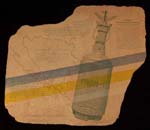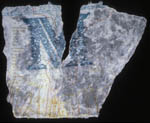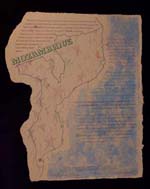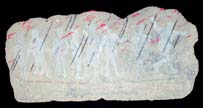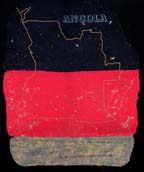| Land
of Proms 2004 18.5” x 16.5”, irregular. Letterpress, woodcut, and polymer relief on variable handmade paper. Edition 27. The Yugoslav PROM-1 landmine used in Bosnia-Herzegovina is the subject of this print on variable handmade paper. With a large image of a PROM and a map of Bosnia, the print examines facts about the mine's manufacture and use in the Balkans war. The blue, white, and yellow stripes are colors from the Bosnian flag. $500 |
|
For
Luis and Domingos 2004 |
|
| An
African Story 2004 13” x 16”, irregular. Letterpress, woodcut, and polymer relief on variable handmade paper with pulp painting. Edition 20. Facts about Mozambique, its wars, and its mine victims are printed with an outline map. Blue pulp painting suggests the sea and the long, beautiful coast of Mozambique while the text describes the two internal wars of over thirty years and their effects on the population. $500 |
|
| Children
of War 2005 20.25” x 10”, irregular. Woodcut and letterpress on variable, stenciled handmade paper. Edition 33. Concentrating on the facts about children in Angola, this print states: “In Angola, children represent 49% of landmine casualties.” “The amputee population is estimated at 70,000, of which some 8,000 are children under the age of fifteen.” It seems that among mine-affected countries, Angola’s children have been very heavily impacted. |
|
Whose
Flag? 2005 |
